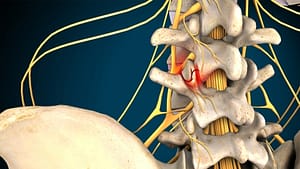What is Facet Joint Syndrome
Facet joint syndrome is pain at the joint between two vertebrae in your spine. Another term for facet joint syndrome is also osteoarthritis.
The facet joints are the joints in your spine that make your back flexible and enable you to bend and twist. These joints also keep the back from slipping too far forward or twisting around without limits. The nerve roots pass through these joints to go from the spinal cord to the arms, legs and into other parts of the body. Nerves exit your spinal cord through these joints on their way onto other parts of your body. Healthy facet joints have cartilage, which allows your vertebrae to move smoothly against each other without grinding. Each joint is lubricated with synovial fluid for additional protection against wear and tear.
When these joints get swollen because of injury or arthritis, it causes pain. If the affected joint is in the neck, it may cause headaches and difficulty moving the head. If it is in the back, it may cause pain in the lower back, buttocks or thighs.
Fact Joint Syndrome Causes
Facet joint syndrome can be caused by a combination of aging, pressure overload of your facet joints, and from injury.
Pressure overload on your facet joints is probably caused by degeneration of the intervertebral discs in your spine. As the discs degenerate, they wear down and begin to collapse. This degeneration then narrows the space between each vertebra. This narrowing of the space between each vertebra affects the way your facet joints line up. When this occurs, it places too much pressure on the articular cartilage surface of the facet joint. The excessive pressure leads to damage of the articular surface and eventually the cartilage begins to wear away.
When facet joint arthritis gets bad enough, the cartilage and fluid that lubricate the facet joints are eventually destroyed as well, leaving bone rubbing on bone. Bone spurs begin to form around the facet joints. When bone spurs develop, they can take up space in the foramen (the opening between vertebrae where nerve roots exit the spine) and press into nerve roots. As the bone spurs begin to grow larger, they can eventually extend into the spinal canal itself. This leads to narrowing of your spinal canal, also called spinal stenosis.

Facet joint syndrome is caused by a combination of aging, pressure overload on the facet joints, and injury

Facet Joint Syndrome can result in a pinched nerve if the joint becomes too swollen and enlarged
Symptoms
Pain, numbness, and muscle weakness associated with facet joint syndrome affects different parts of your body depending on which of your nerves are being affected. If the nerves affected are in your cervical spine, you may feel symptoms in your neck, shoulders, arms and hands. If the nerves are in your lumbar spine you may feel symptoms in your buttocks, legs, and feet.
People with this condition usually mention they need to turn their whole body to look to the left or right. The pain and stiffness often associated with this condition can make it difficult to stand up straight or stand from a chair. The person may walk hunched over. The specific symptoms depend on where the affected joint is located and what nerve roots it affects.
If the facet joint becomes too swollen and enlarged, it may block the openings through which the nerve roots pass, causing a pinched nerve. This condition is also called facet hypertrophy.
Diagnosis
The diagnosis of facet joint syndrome usually begins with a complete history and physical exam. Your doctor may order other diagnostic tests as well. X-rays may be recommended to determine whether there are abnormalities in your spine. A CT scan can show more detail about your facet joint surfaces. If the X-rays suggests something may be affecting your facet joints, your doctor may recommend a CT scan to get a better look. A bone scan can be useful in determining whether your facet joints are inflamed. An inflamed facet joint usually shows up as a hot spot on a bone scan.
After a diagnosis of facet joint syndrome is confirmed by injecting an anesthetic and an anti-inflammatory in the joint. If there is immediate relief of pain after the injection, the condition is facet joint syndrome.
Spinal Injection
Your doctor may also recommend you undergo a fluoroscopic injection into your facet joint. During this test, a local anesthetic is injected into the joint. The doctor uses a fluoroscope to make sure the needle is actually in the joint before injecting the medication. Your facet joints are located fairly deep in the upper buttocks and are covered by thick muscle. It is difficult to put a needle into the joint without some guidance. A fluoroscope is a special TV camera that uses X-rays to allow the doctor to see on the screen the exact placement of the needle and to make sure it is positioned accurately.
Once the needle is in the right place, anesthetic is injected to numb your joint. If the pain goes away, your doctor can be relatively sure that the problem is coming from the facet joint that was injected and not somewhere else in your spine. The doctor may also add a dose of cortisone to the injection to help ease your pain. Cortisone is a powerful anti-inflammatory medication that calms the arthritis inside the joint and reduces pain. The effect is usually temporary, but it may last up to several months.
 Skip to content
Skip to content
